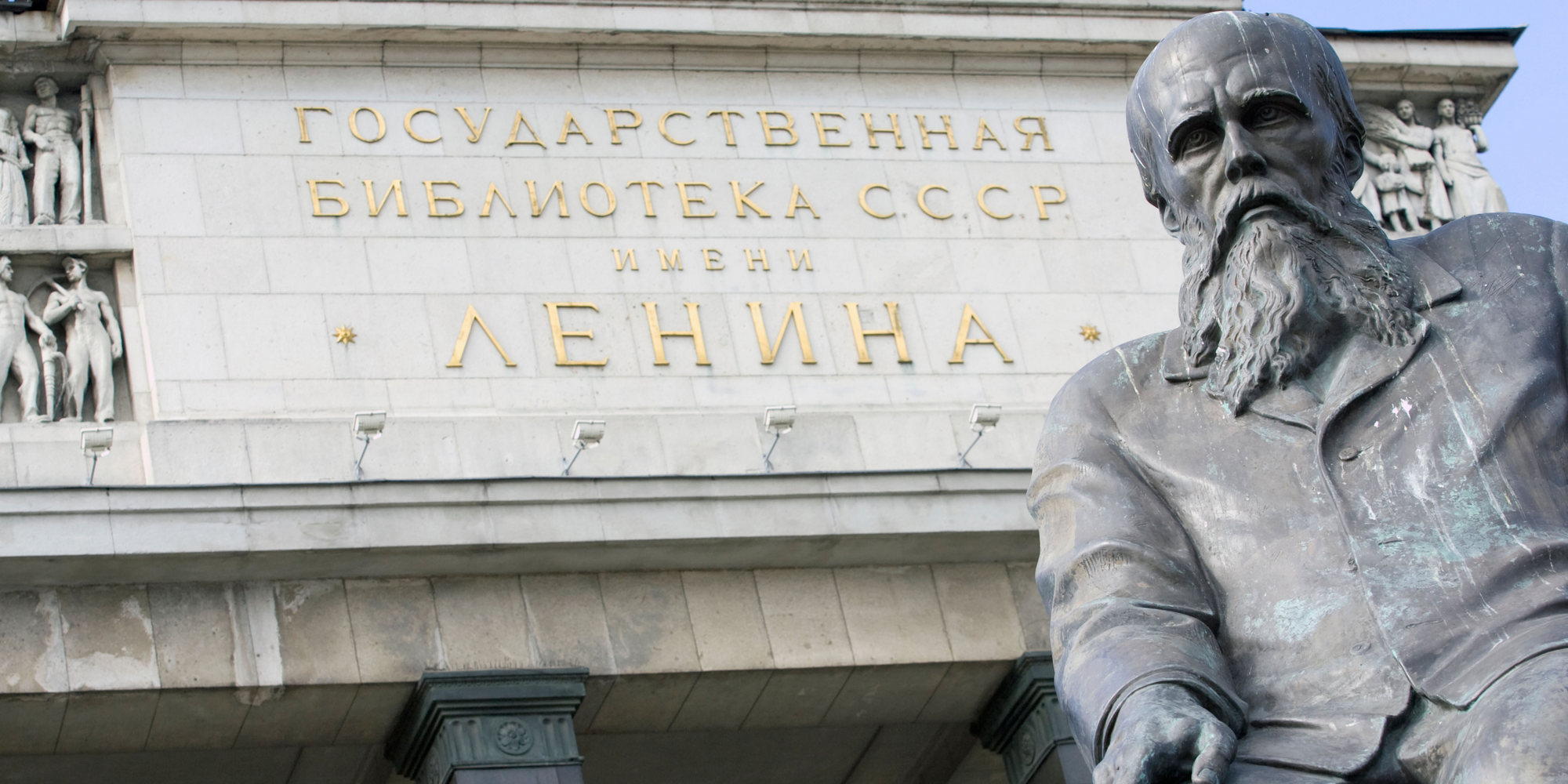
Dostoevsky’s ‘The Idiot’
‘The idea is to depict an absolutely wonderful person.’ (Fyodor Dostoevsky, 1867) Dostoevsky’s ‘The Idiot’
The Idiot is the novel in which Dostoevsky attempted the difficult experiment of creating a central character who embodied goodness. Sally Minogue looks at the resulting fiction.
The Idiot (1869) was the first of the big Russian novels that I read in my youth, and it completely captivated me, largely I think because of the sweet nature of its ‘hero’, Prince Lyov/Lev Nikolayevitch Myshkin. At that point I was unaware that Dostoevsky’s driving aim in the novel was to put pure goodness at its heart, but for me he succeeded entirely. And some 60 years later, he still does, though I have put the warning quotes round ‘hero’ because of course Myshkin is also the eponymous ‘Idiot’ of the novel. For in the complicated, turbulent, morally problematic world depicted in the nineteenth-century Russian novel, if one is simply and entirely good, one must also therefore be a fool. It is this paradox which the novelist explores, along with the underlying question of whether any human being can be always and entirely good. Dostoevsky’s ‘The Idiot’
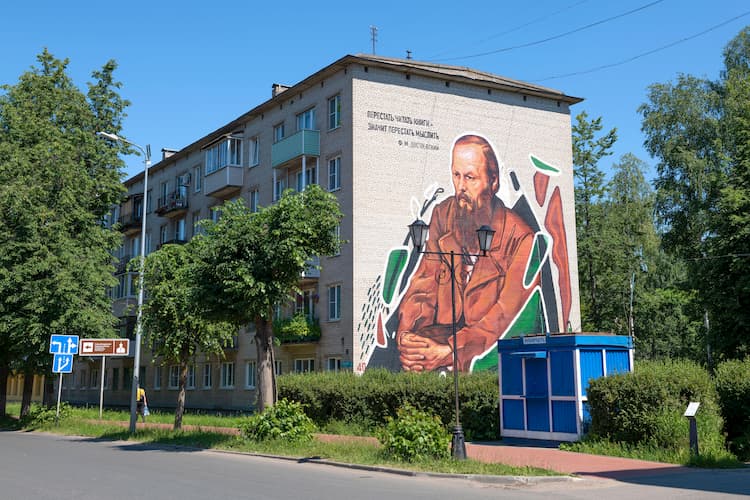
Staraya, Russia
Like all his works, the novel is deeply affected by Dostoevsky’s political history as a writer and his complicated relationship with an authoritarian Russian monarchy. He had always skirted close to the wind of political orthodoxy, with arrest and near-execution in 1849, commuted to penal servitude including hard labour in Siberia for 8 years, reduced to 4 years by Tsar Nicholas I. Inevitably this experience in his late twenties and early thirties marked him both physically and imaginatively. And in 1853 his epileptic seizures began. The accession of the more liberal Tsar Alexander II in 1855 afforded some relaxation of the censorship which had dogged writers up to this point. Thereafter his writing career developed but always in conjunction with the literary journals which at that time were the main means of first publication of new fiction. With his brother Mikhail he founded the journal Time in 1860, and then later in 1864 they produced together the journal Epoch, and these were the main organs of his publication. However in the lead-up to what would be the writing of The Idiot, Dostoevsky sustained two major blows: his first wife Marya and his brother Mikhail both died in 1864. A side effect of this was that his financial family burdens increased just at a time when he himself was deeply in debt, largely because of his chronic gambling habit. These debts forced him into self-imposed exile in Europe where with his new young second wife Anna he lived in poverty – and again he was gambling. Anna became pregnant, and finally they found some stability in Geneva, whilst he settled to writing what would become The Idiot. His own affliction, epilepsy, which during this time was particularly troublesome, he gave also to his hero Myshkin, raising it thereby from the debilitating and frightening illness the author suffered to something connected almost mystically to Myshkin’s purity and innocence. However one might view Dostoevsky’s personal flaws, in his writing he was brave and uncompromising, and his decision to try to depict absolute goodness in his new novel was made in the belief that ‘I don’t think there can be anything harder than that, especially in our time’. Dostoevsky’s ‘The Idiot’
With this theme at its core, the structure of the novel itself is quite wayward and frequently digressive. Its opening, on a train rushing from Warsaw to St Petersburg, establishes a sense of the unsettled and unrooted, as we are introduced to Myshkin, thin, fair-complexioned, and inappropriately dressed for the freezing weather. His face is ‘blue with cold’, but also ‘pleasing’ and his eyes are ‘large and dreamy’, while all his belongings are tied up in a small bundle in ‘an old faded silk handkerchief’. (3-4) The impression of unattachment to the world is borne out as we hear more about him when a fellow-traveller, Parfyon Semyonovitch Rogozhin, asks for his name and circumstances. We readers do not know it at this point, but the fates of Myshkin and his dark counterpart, Roghozhin, will be intimately connected right up to the very end of the novel. A third character in the train carriage, Lebedyev (significantly we do not learn his first name or his patronymic), interlocutes between the two – a means of giving the reader information whilst also being clearly relegated to a minor position. Myshkin and Rogozhin, both headed for St Petersburg society, whilst also being lone outsiders to it, then further interact with three key families. These are the Epanchins, the wife and mother Lizaveta Prokofyevna being a distant relative of Myshkin; the Ivolgins, whose son Gavril (Ganya) works for General Epanchin and lives, with his family, within his household; and the Lebedyevs (as above), somewhat down on their luck. The three families represent different stages of social success.
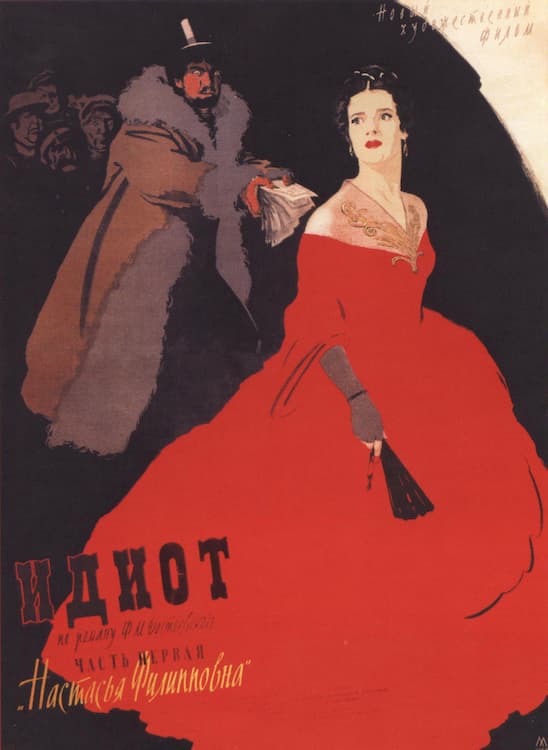
Movie poster “The Idiot” ,Russian State Library, Moscow.
As soon as Prince Myshkin enters St Petersburg society, first through the Epanchins who give him lodging, then through the other families in various ways, he meets corruption. It emerges only gradually, but the apparently solid bourgeois Epanchin family are awash with it. General Epanchin is trying to marry off one of his daughters to his business partner Afanasy Ivanovitch Totsky (usually just Totsky), in spite of knowing that the same Totsky has taken sexual advantage of the ward who was left in his care, the beautiful Nastasya Filippovna Barashkov. Part of the arrangement is that Nastasya herself – seen now as compromised – be married off to the General’s assistant Ganya. To this end, Totsky has promised 75,000 roubles towards the match. A complication in all of this is that the aforesaid Rogozhin has already declared to Myshkin on their first meeting his passion for Nastasya.Dostoevsky’s ‘TheThe Idiot’
We become aware very quickly that this is a world in which gossip circulates – we hear of Nastasya before we ever meet her, and her reputation, which is in fact entirely undeserved since it is Totsky who has ruined her, goes before her. Talked about in a train carriage between three men, her portrait is then pored over by other men (incidentally including Myshkin). Yet the real perpetrators of immorality are those same men who are trying to arrange a deal which includes not only her but also the General’s own daughter. Yet interestingly Nastasya still holds a certain amount of power, fuelled by her early experiences and perhaps by her own beauty. In Dostoevsky’s novels women certainly have power, though it may be differently achieved than that of the men. The three Epanchin daughters are presented as independently-minded women, with their own thoughts and feelings. Yet at the same time the machinations that go on behind their backs undermine this impression. It is one example of the layers of society that Dostoevsky exposes. But he also exposes the way in which those who are manipulated have no real idea of it. The Epanchin girls believe themselves to be free agents; but of course they are not. Nastasya by contrast has earned a sort of agency through her mistreatment; but it ends only in her making a choice which further damages her. Women in the novel are thus shown to be less free than men, since largely it is the men who control their worlds. Yet at the same time Dostoevsky gives due weight to women and their centrality. Dostoevsky’s ‘The Idiot’
Money too plays a large part in the exploration of good and evil. There is an open bidding for Nastasya which redounds, quite wrongly, on her. That this is instigated by Rogozhin is the more ironic as he actually has a passion for her. Prince Myshkin surveys all this and sees into the soul of Nastasya; from this point he is her defender, but not her lover. When Rogozhin returns with the 100,000 roubles – effectively to buy Nastasya – Myshkin offers to marry her. It is important to realise here that he does this not for love but because he thinks it is the right thing to do. He wants to save Nastasya; but she goes off with Roghozin anyway – though only after flinging the 100,000 roubles into the fire.
This is one of several incidents of great drama and sometimes violence in the novel, a characteristic as we have seen of all the major Russian novels of this period. Sometimes this drama is refracted through storytelling rather than being presented directly, as when Myshkin falls into conversation with the footman while waiting to be granted access to General Epanchin. This servant is already deeply discomfited by the Prince’s insistence on staying with him rather than moving to the grander waiting room – an early indication in the novel both of Myshkin’s democratic impulse to treat all human beings equally, and the sometimes complicated consequences of this:
The prince’s conversation seemed simple enough, yet its very simplicity only made it more inappropriate in the present case, and the experienced attendant could not but feel that what was perfectly suitable from man to man was utterly unsuitable from a visitor to a manservant … either the prince was some sort of impostor who had come to beg of the general, or he was simply a little bit soft and had no sense of dignity, for a prince with his wits about him and a sense of his own dignity, would not sit in an anteroom and talk to a servant about his affairs. (17) Dostoevsky’s ‘The Idiot’
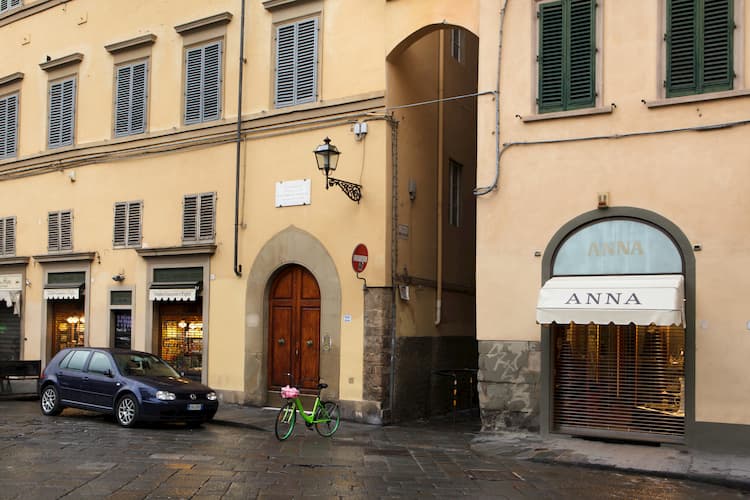
Piazza Pitti in Florence, Tuscany, Italy
This is an extremely interesting passage in a number of ways. In it, Dostoevsky slides effortlessly into the inner workings of a man who at most plays only a bit part in events. This is his brief moment on the stage of the novel, but his thoughts are shown to be as important to reveal as those of major characters. The narrative sleight of hand here moves from the omniscient narration which is the foundation of the novel’s technique to a sort of modernist internalization, then back out again as dialogue is restored as the main mode. Much later in the novel, at the start of Part 4, Dostoevsky puts himself outside of his fiction altogether to discuss the whole business of the creation of characters in a novel, and one of the points he makes is the difficulty of dealing with ‘ordinary’ people:
What is an author to do with ordinary people, absolutely ‘ordinary’, and how can he put them before his readers so as to make them at all interesting? It is impossible to leave them out of fiction altogether, for commonplace people are at every moment the chief and essential links in the chain of human affairs; if we leave them out, we lose all semblance of truth. (418) Dostoevsky’s ‘The Idiot’
The manservant is the ultimate ‘ordinary’ person, yet for this moment our author gazes at him with as great care as he affords to the legion of far more important characters in the novel. It is through his thoughts that we see the first characterization of Prince Myshkin as ‘soft’, the only alternative to his being ‘an impostor’. In this small way we see the conundrum that the Prince repeatedly offers to those he comes into contact with as he moves through a world in which he is unique.
The story Myshkin goes on to tell the manservant is also characteristic of a number of other storytellings in the novel depicting violent events. He describes to the servant, fascinated in spite of himself, the executions he has seen by guillotine in France, and the reactions of those just before the blade falls:
‘I’d no idea that a grown man, not a child, a man who never cried, a man of forty-five could cry for fear! What must be passing in the soul at such a moment; to what anguish it must be brought! It’s an outrage on the soul, that’s what it is! It is written “Thou shalt not kill” so because he has killed, are we to kill him? No, that’s impossible. It’s a month since I saw that, but I seem to see it before my eyes still. I’ve dreamt of it half a dozen times.’ (19) Dostoevsky’s ‘The Idiot’
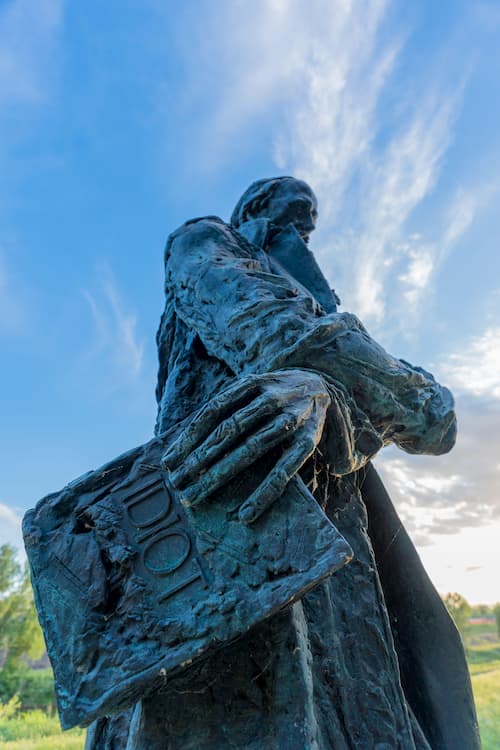
Monument to Dostoevsky, Florence, Italy
Myshkin goes on to explore his ideas about spiritual and physical suffering, talking both philosophically and humanly. There couldn’t be a better demonstration both of his utter sense of equality with the servant, and his own horror at the extent of human suffering, and his sense of the importance of forgiveness in the face of it. This is to be important in the course of events in the novel, since Myshkin has much to forgive. The servant too is moved, and offers the only thing in his power to Myshkin (which he has previously refused), a place where he might smoke. The little bathos brings the scene down, but it remains a key one in the novel, even though as readers we might not necessarily notice it.
This act of storytelling recurs as a motif throughout the novel, echoing the many actual violent events of the novel, which include stabbings, murder, drunken violence, suicide, Myshkin’s own seizures, the powerful episode when Nastasya turns a riding crop on an officer who has insulted her, which almost turns into a fight between the two, and the final dreadful murder of Nastasya. The stories within a novel also remind us that after all this is also a made-up story we are reading. Dostoevsky pushes our suspension of disbelief as far as he can, constantly investigating his own act of fiction. But the writing itself is so powerful that we remain engaged, believing, and deeply moved. Dostoevsky’s ‘The Idiot’
Our engagement with Prince Myshkin himself is of course key to this. Like the puzzled servant, we observe his constancy of approach. He never follows his self interest; rather he does what he thinks to be right. The woman he really loves is Aglaia Epanchin, and she too is fascinated and moved by him. Inevitably this works out badly since the Prince can’t ever achieve the happiness he might want; rather he has to find happiness in the fate of others. As a result he decides to marry Nastasya to save her broken soul. Nastasya breaks away from the marriage at the last minute and goes instead with Rogozhin. When Myshkin pursues them he finds that Rogozhin has murdered Nastasya. In a bizarre final scene, the two men keep watch over the dead woman in a crazy bonding of grief.
So where does this leave us with the results of Prince Myshkin’s goodness? Clearly his interventions do not produce the ‘good’ that he seeks. He disappoints Aglaia, and perhaps disappoints himself in not pursuing that love. His intended marriage to Nastasya, based on pity, results only in her fleeing with Roghozin to a fatal end. Wherever Myshkin intervenes, though his goodness is apparent and indeed affects those he meets positively, the result is bad rather than good.
However, I don’t think Dostoevsky intended that to be the final idea expressed by The Idiot. Rather he shows us a man whose impetus is entirely for good, whose innocence shines through, and whose goodness affects all those he meets. That his good intentions meet violent ends is not his doing. What Dostoevsky perhaps shows most tellingly is the corruption – especially that which links money, power and desire – that is made the more apparent by its contrast with Myshkin’s always good intentions.
Myshkin has sometimes been called a holy fool, and many analogies have been made between him and Christ. This simple coupling is I think a mistake. Dostoevsky is as much interested in the absurdity of the human condition as in its salvation, hence the whole idea of making Myshkin ‘The Idiot’. This is a novel which looks towards the abyss of irrational death as much as to the domestic rhythms of Russian life. Whatever else we take away from it, for myself I still take the abiding innocent goodness and sweet nature of Prince Myshkin, but in its always flawed human form.
Main image: Statue of Dostoevsky in front of the Russian State Library Credit: George Blonsky / Alamy Stock Photo
Image 1 above: Artwork on the wall of a residential building, Staraya, Russia. Credit: Viktor Karasev / Alamy Stock Photo
Image 2 above: Movie poster ‘The Idiot’, Russian State Library, Moscow. Credit: Album / Alamy Stock Photo
Image 3 above: The house, with commemorative plaque, in Piazza Pitti in Florence, Tuscany where Dostoyevsky lived with his wife Anna from 1868 to 1869 and completed ‘The Idiot’.
Credit: Vladimir Pomortzeff / Alamy Stock Photo
Image 4 above: Monument of Dostoevsky in Florence. Credit: Aleksei Gorovoi / Alamy Stock Photo
For more on Dostoevsky’s life and works, see: International Dostoevsky Society & North American Dostoevsky Society
Our edition of ‘The Idiot’ is here
It is also part of our new Dostoevsky Box Set, which you can find here
Dostoevsky’s ‘The Idiot’
Books associated with this article
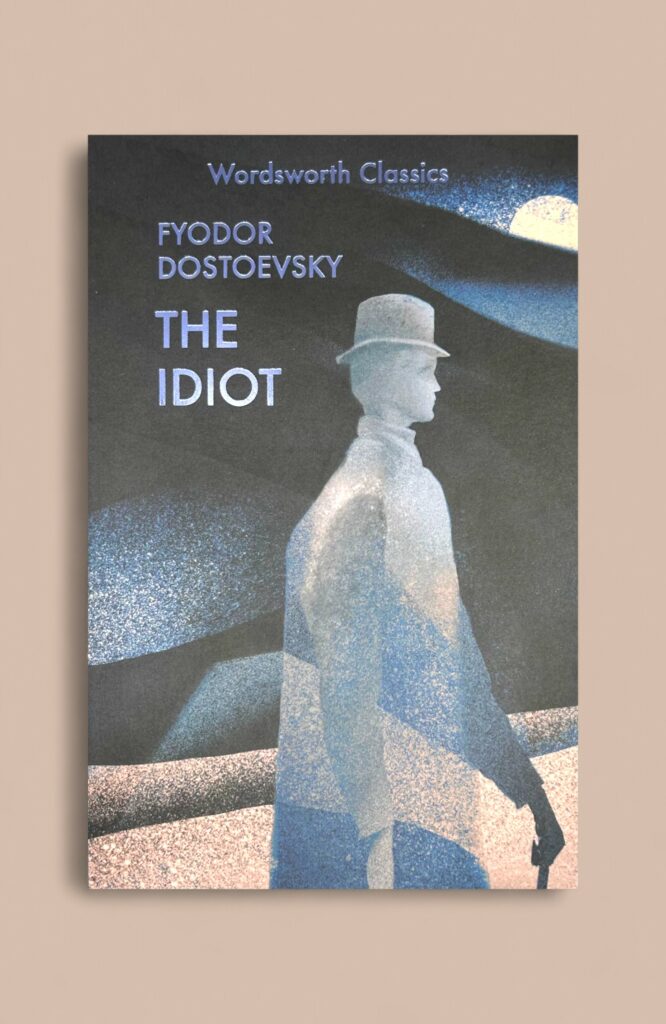
The Idiot
Fyodor Dostoevsky
